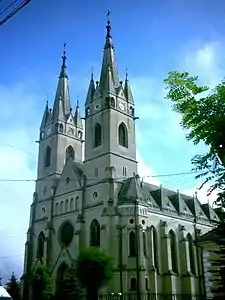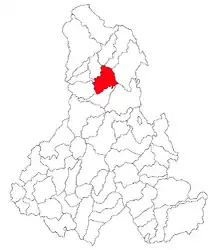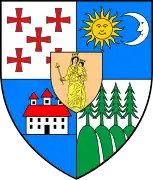Ditrău
Ditrău ([diˈtrəu]; Hungarian: Ditró or Gyergyóditró [ˈɟɛrɟoːditroː]) is a commune in Harghita County, Transylvania, Romania. It is composed of three villages:
- Ditrău / Ditró
- Jolotca / Orotva
- Țengheler / Csengellér or Cengellér
Ditrău
Ditró | |
|---|---|
 The Big church | |
 Coat of arms | |
 Location in Harghita County | |
 Ditrău Location in Romania | |
| Coordinates: 46°49′N 25°31′E | |
| Country | |
| County | Harghita |
| Government | |
| • Mayor | Ferenc Bardócz (Ind.) |
| Area | 114.99 km2 (44.40 sq mi) |
| Population (2011)[1] | 5,483 |
| • Density | 48/km2 (120/sq mi) |
| Time zone | EET/EEST (UTC+2/+3) |
| Postal code | 537090 |
| Area code | +40 266 |
| Vehicle reg. | HR |
It sits near Martonca River, above 714 m from the sea level. The highest point of Ditrău is the Piricske height. Ditrău was first registered in 1567, as Gitró, with 26 gates. There is a significant syenite reserve near the village.
History

The villages belonged first to the Székely seat of Gyergyószék, which was subsequently absorbed into Csíkszék, until the administrative reform of Transylvania in 1876, when they fell within the Csík County in the Kingdom of Hungary.
After the Treaty of Trianon of 1920, they became part of Romania and fell within Ciuc County during the interwar period. In 1940, the second Vienna Award granted the Northern Transylvania to Hungary and the villages were held by Hungary until 1944.
After Soviet occupation, the Romanian administration returned and the commune became officially part of Romania in 1947. Between 1952 and 1960, the commune fell within the Hungarian Autonomous Province, between 1960 and 1968 the Mureș-Hungarian Autonomous Province. In 1968, the province was abolished, and since then, the commune has been part of Harghita County. From January to March 2020, a xenophobic incident occurred between the local population and two Sri Lankan immigrants who worked at the bakery Ditrói Pékség.[2]
Demographics
The commune has an absolute Székely (Hungarian) majority. According to the 2002 census it has a population of 5,480 of which 98.87% or 5,418 are Hungarian.
Economy
Once upon a time, the village was known for its mining activity - the ditroit, a marble-like sodalite stone used in construction.
Tourist attractions
- Szent Katalin Church, built in 1653.
- Near Szent Katalin Church there is a 75m high church built between 1908 and 1913, which is known locally as the "big" church. This is the second highest church in this region. Its construction cost 800,000 Austro-Hungarian koronas.
Notable residents
- Tivadar Puskás (1844-1893), Hungarian inventor of the telephone exchange
References
- "Populaţia stabilă pe judeţe, municipii, oraşe şi localităti componenete la RPL_2011" (in Romanian). National Institute of Statistics. Retrieved 4 February 2014.
- Zoltán, Sipos (6 February 2020). "Furia anti-imigranţi de la Ditrău se pliază peste cel mai clasic tip de exploatare. Reportaj VIDEO". Átlátszó Erdély (in Romanian).
